7 Automation Tools to Save 10 Hours Per Week
By The Shed |
December 20, 2025
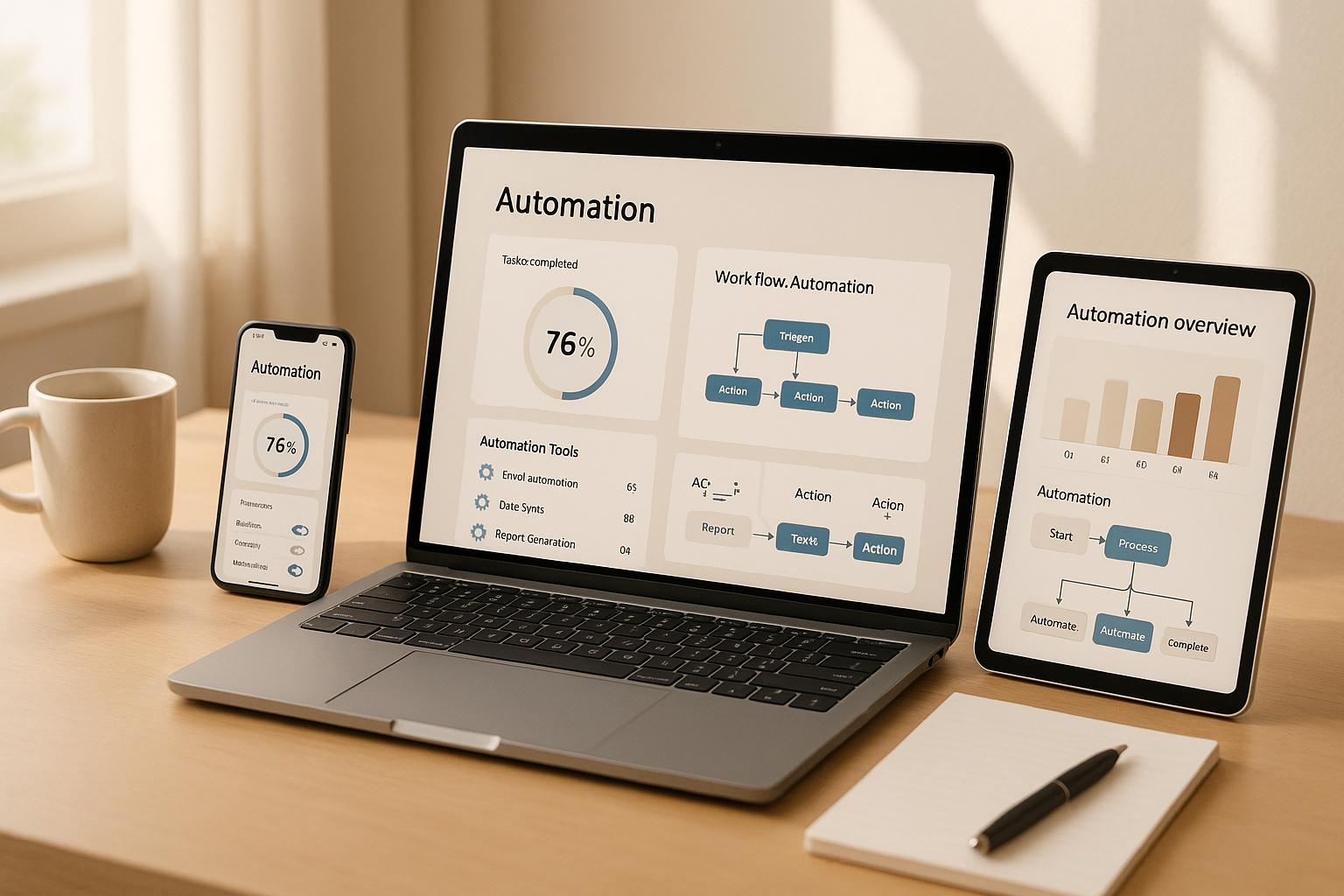
Want to save up to 10 hours a week? These 7 automation tools can handle repetitive tasks like data entry, scheduling, and email management, freeing up your time for more impactful work. From AI-powered platforms to workflow management solutions, these tools are designed to improve efficiency while reducing errors. Here’s a quick breakdown:
- TheShed.io: A directory to find automation tools for tasks like invoicing and scheduling.
- Relevance AI: AI agents for sales, customer support, and pricing analysis.
- Stack AI: No-code platform for creating intelligent workflows.
- Zapier: Connects apps to automate workflows with over 7,000 integrations.
- n8n: Open-source tool for developers to customize automations.
- Motion: AI-powered scheduling and task management.
- Fathom: Meeting assistant for recording, transcribing, and summarizing calls.
Quick Comparison
| Tool | Focus Area | Best For | Pricing (Starting) |
|---|---|---|---|
| TheShed.io | Task automation directory | SMBs, project managers | Freemium |
| Relevance AI | AI agents for workflows | Sales, marketing, operations | $19/month |
| Stack AI | Intelligent workflows | Enterprises, IT teams | $199/month |
| Zapier | App integration | SMBs, marketers | Free |
| n8n | Open-source automation | Developers, tech teams | Free (self-hosted) |
| Motion | Scheduling and task mgmt. | Professionals, executives | $19/month |
| Fathom | Meeting documentation | Sales, project managers | Free |
Automating tasks isn’t just about saving time - it reduces errors, improves productivity, and lets you focus on what matters most. Whether you’re looking for simple workflows or AI-driven solutions, one of these tools is likely a fit for your needs.
20 Workflow Automation Tools to Streamline Business Processes
How Automation Tools Save Time
Automation tools handle repetitive tasks by following predefined rules and triggers. Instead of dedicating hours to things like data entry, responding to emails, or generating reports, these tools take over, allowing you to focus on strategic tasks, creative problem-solving, and other activities that drive impact.
The data speaks volumes. Research from McKinsey shows that about 60% of jobs have at least one-third of tasks that could be automated. Additionally, 73% of IT leaders report that automation can save up to 50% of the time spent on routine tasks. This means professionals can reclaim a significant chunk of their workday.
The Core Benefits of Automation
One standout advantage of automation is its ability to minimize errors. Repetitive tasks performed by humans are prone to mistakes, especially during busy times or when fatigue sets in. Automated systems, on the other hand, follow consistent processes, reducing the risk of costly errors in areas such as invoice processing or data transfers.
Another benefit is improved employee satisfaction. A survey found that 65% of knowledge workers experience less stress when repetitive tasks are automated. With fewer mundane responsibilities, employees can focus on meaningful work, leading to increased productivity and lower turnover rates.
Common Tasks Perfect for Automation
Email management is a great example. Automation tools can organize incoming emails, send follow-up sequences, and route customer queries to the right team. For instance, in March 2023, Spotify used Mailchimp's Email Verification API to clean up its 45-million subscriber database. This effort reduced the email bounce rate from 12.3% to 2.1% in just 60 days, boosting deliverability by 34% and adding $2.3 million in revenue.
Scheduling and calendar management are also ripe for automation. Tools can coordinate meetings, send reminders, and handle rescheduling, cutting down on endless back-and-forth emails.
Data entry and reporting are major time sinks for many teams. Automating tasks like report generation or scheduling social media posts can save over 6 hours a week, freeing up time for more important projects.
Invoice processing and billing benefit significantly from automation. Instead of manually creating invoices, tracking payments, or sending reminders, automated systems handle these tasks quickly and accurately, improving efficiency across the board.
Start by automating the tasks that take up the most time in your day-to-day operations.
Getting Started with Automation
To begin, identify the tasks that consume the most time in your daily or weekly routine. Processes like lead management or employee scheduling are excellent candidates for automation.
"Automation applied to an efficient operation will magnify the efficiency." - Bill Gates
Start small by automating simple, single-step tasks before moving on to more complex workflows. This gradual approach helps you get comfortable with automation tools while delivering immediate results.
The benefits are undeniable. A full 90% of knowledge workers say automation has improved their workplace experience, and 76% of businesses use it to standardize daily workflows. With current technology capable of automating up to 50% of work activities, there’s never been a better time to take advantage of these tools and reclaim your time.
1. TheShed.io
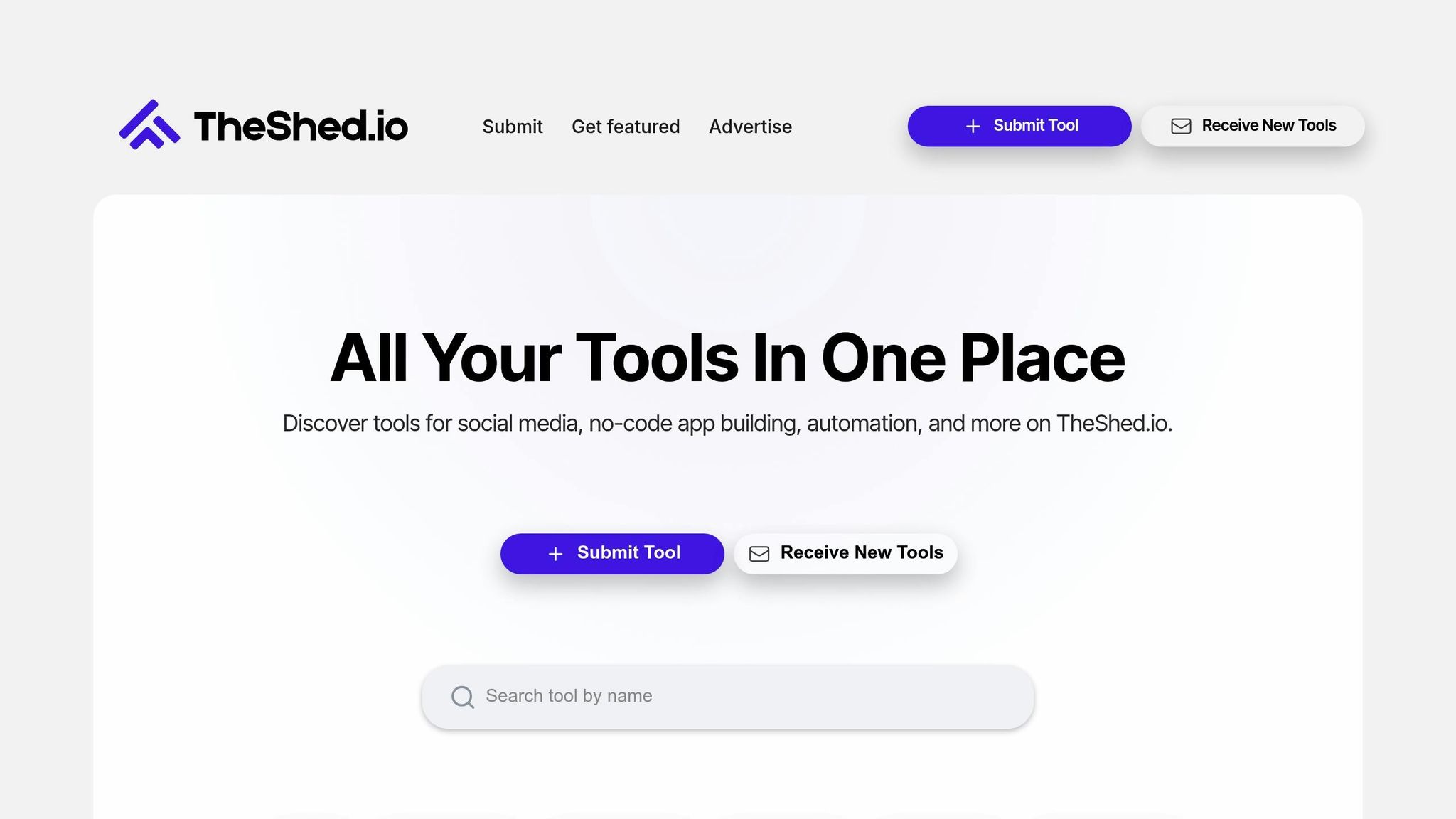
TheShed.io is a directory designed to connect users with automation tools that simplify business operations. Acting as a resource hub, it helps professionals find solutions to replace manual processes across various business functions.
Core Automation Focus
TheShed.io focuses on software solutions that automate repetitive tasks. It highlights tools for areas like inventory management, scheduling, and invoicing - tasks that often eat up hours of manual effort every week. By automating these processes, businesses can save time, reduce errors, and maintain consistency in critical operations. This targeted approach makes it a go-to platform for streamlining workflows.
Key Features
The platform categorizes tools powered by AI and designed for productivity, making it easier for users to find what they need. Whether you're searching for marketing automation, development workflows, or no-code solutions, the structured layout ensures quick and efficient browsing.
Additionally, TheShed.io features highlighted listings that showcase particularly effective tools, further simplifying the selection process.
Best For
TheShed.io is perfect for teams and small to medium-sized businesses aiming to adopt automation without needing advanced technical skills. Project managers and operations teams will appreciate the centralized directory for quick tool comparisons. For growing businesses, the platform offers scalable automation solutions to tackle bottlenecks as they expand.
Pricing
The platform operates on a freemium model, allowing users to browse the directory and access basic listings for free - ideal for businesses on a tight budget. For providers, options like featured listings and advertisements are available, with pricing based on placement and duration.
2. Relevance AI
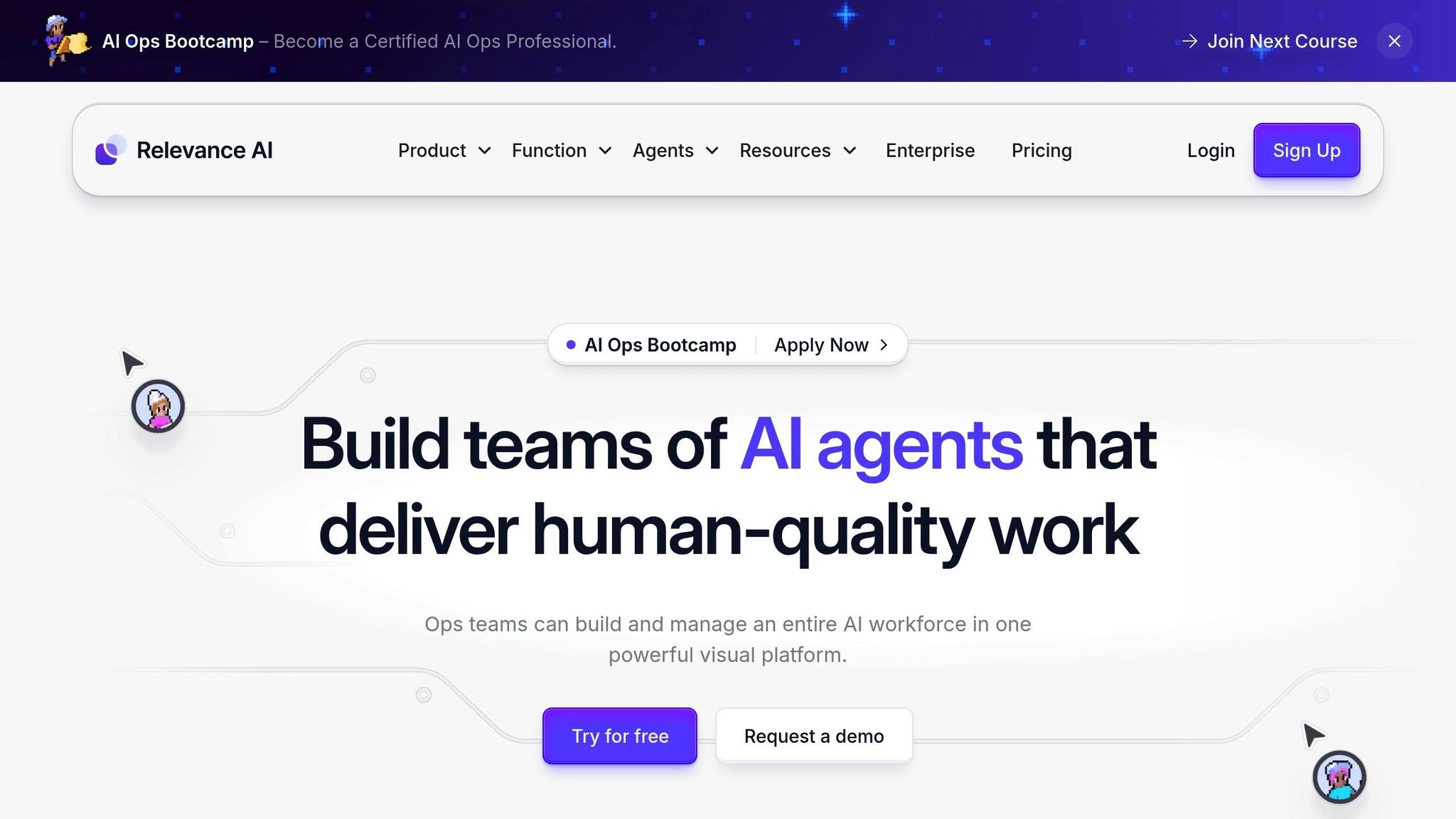
Relevance AI takes workflow automation to the next level by using coordinated AI agents to simplify tasks like lead qualification, customer support, research, and pricing analysis. These AI "teams" don’t just save time - they make complex processes more efficient.
Core Automation Focus
Relevance AI focuses on automating workflows across sales, marketing, customer support, and operations. The platform leverages AI agents that collaborate seamlessly to handle intricate tasks, creating a system where each agent contributes its expertise.
As founder Jacky Koh puts it:
"When we founded Relevance AI, we recognized that the true power of AI agents wouldn't come from isolated capabilities but from collaboration - agents collaborating to manage complex processes."
A great example of this in action is Klarna’s autopilot chatbot, which managed 2.3 million chats in 35 languages over four weeks. That’s equivalent to the workload of 700 full-time agents, with customer satisfaction levels staying the same and ticket resolution times dropping from 11 minutes to just 2 minutes.
This collaborative approach is what drives the platform’s impressive capabilities.
Key Features
Relevance AI offers a range of tools to help businesses quickly deploy and manage custom AI solutions:
- A drag-and-drop AI agent builder and pre-built agents for tasks like outreach, pricing, support, and SEO make setup quick and approachable.
- The Workforce visual canvas allows users to design multi-agent systems without needing to write code. These AI teams adapt to real-time changes and provide updates as they work independently.
- Seamless integration with popular tools like HubSpot, Salesforce, Zapier, Google Docs, LinkedIn, and Slack ensures smooth implementation into existing workflows.
- Users can easily clone and tweak agents for different roles, making it simple to expand automation across departments.
This approach helps businesses reclaim valuable time by automating multi-step processes with ease.
Best For
Relevance AI is ideal for small to mid-sized businesses aiming to streamline operations without breaking the bank. Sales teams, regardless of size, can benefit from automating lead scoring, qualification, and follow-ups.
It’s also a great fit for subject-matter experts who need to simplify complex workflows but don’t have coding expertise. Operations teams and project managers will find the platform especially useful for building AI systems that handle multi-step tasks autonomously.
Pricing
Relevance AI offers flexible pricing to suit businesses of all sizes:
- Free Plan: Includes 100 credits per day, 1 user, and 10MB storage - perfect for testing the platform.
- Pro Plan: $19/month, designed for individuals or small teams.
- Team Plan: $199/month, tailored for collaborative workflows with shared workspaces.
- Business Plan: $599/month, ideal for multi-agent automation and enterprise-grade security.
- Enterprise Plan: Custom pricing for large-scale businesses, offering unlimited AI runs and dedicated support.
The platform boasts a 4.5-star rating on G2, with users highlighting its balance of functionality and user-friendliness.
3. Stack AI
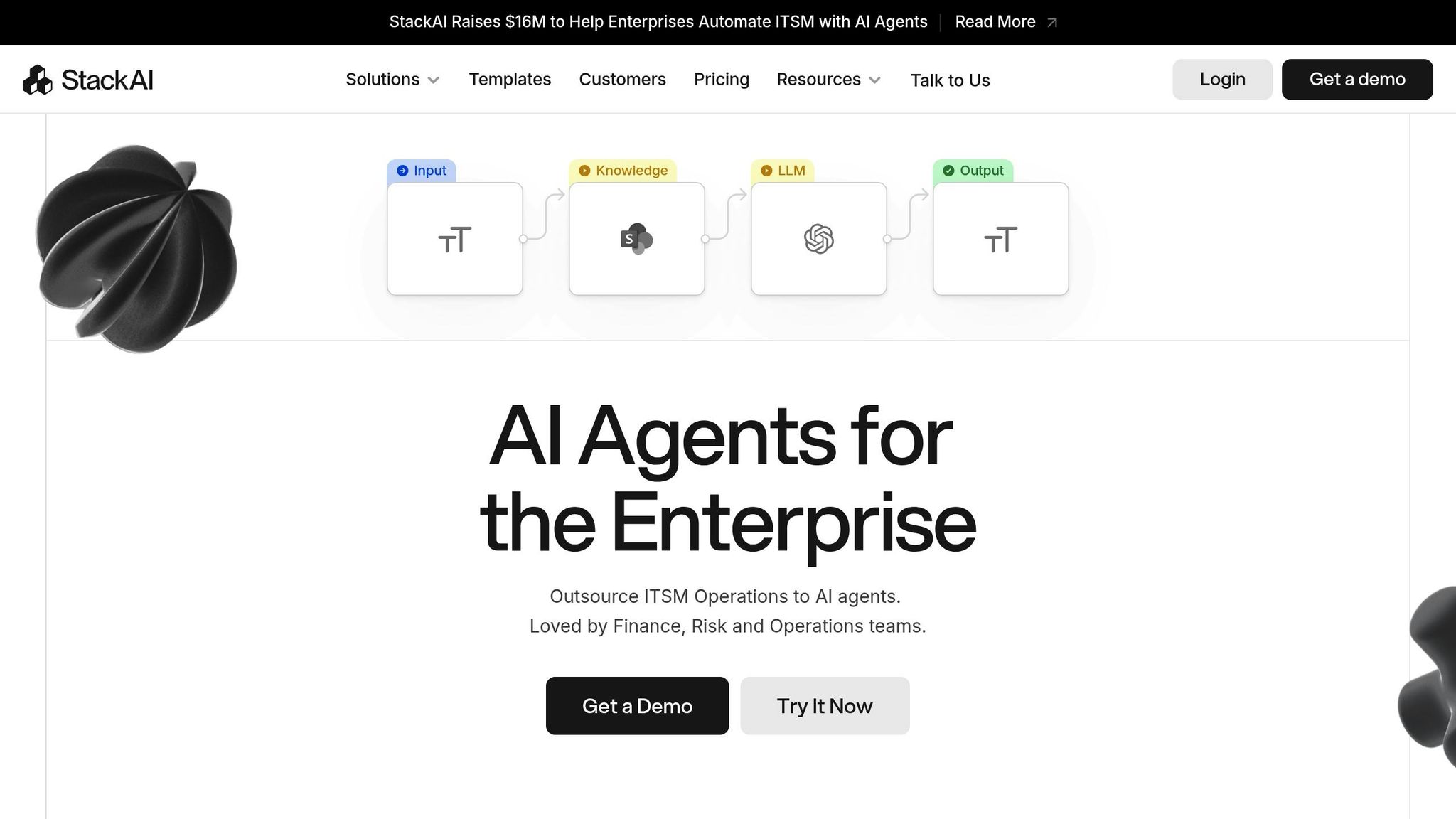
Stack AI simplifies business operations by leveraging no-code, AI-driven automation. Its primary focus is on connecting data sources with large language models, enabling intelligent workflows that can reason and make decisions in real time. Unlike basic task automation tools, Stack AI takes automation to the next level by integrating AI and data connectivity to streamline workflows even further.
Core Automation Focus
Stack AI specializes in creating AI agents and chatbots that handle complex processes without requiring any coding. This includes automating tasks like data analysis, report generation, and responding to routine inquiries. By taking over these repetitive operations, the platform allows teams to dedicate their energy to strategic initiatives. Additionally, its intelligent chatbots improve customer support through real-time, context-aware interactions.
One standout feature is its AI Routing, which supports real-time decision-making tailored to specific contexts. This adaptability ensures workflows can respond intelligently to a variety of situations.
As co-founder Bernardo Aceituno puts it:
"Our platform connects data sources and LLMs to build powerful workflow automations".
The platform's rapid adoption - over 200 customers in just six months - highlights its effectiveness and reliability.
Key Features
Stack AI offers an array of tools designed to meet the demands of enterprise-level automation:
- Visual drag-and-drop interface: Build AI applications without writing a single line of code, making it accessible even for non-technical users.
- Extensive integrations: Connects seamlessly with leading AI models and data sources like Airtable, SharePoint, OneDrive, and Notion.
- 1-Click Agentic RAG: Simplifies workflow management with human-in-the-loop controls.
- Enterprise-grade security compliance: Ensures your processes meet stringent security and privacy standards.
- Custom deployment options: Choose between user-friendly interfaces or API-based setups.
Additionally, Stack AI includes prompt optimization tools to fine-tune workflows for maximum efficiency.
Best For
Stack AI is particularly well-suited for enterprises looking to scale AI automation across various departments and products. IT and transformation teams will appreciate its focus on enterprise-level features and compliance.
The platform shines in managing complex, multi-product workflows. For example, LifeMD has successfully used Stack AI to streamline and scale its AI-driven processes. Chief Information Officer Stefan Galluppi shares:
"StackAI helps our team streamline the management and scaling of complex AI workflows across multiple products. We've used it to test, deploy, and manage a wide range of Agents - StackAI provides a reliable foundation for building and running production-ready AI systems".
Educational institutions also benefit greatly from Stack AI. The MIT Martin Trust Center, for instance, built AI assistants for students in just a few weeks. Gen AI Lead Doug Williams explains:
"StackAI was paramount in easily building AI assistants for our students, in a matter of weeks. We were able to transform the students' learning journey ourselves, without the need to code or become an expert in AI".
Pricing
Stack AI offers flexible pricing plans to cater to organizations of all sizes:
- Free Plan: $0/month, includes 500 runs per month, 2 projects, and 1 seat - ideal for testing the platform's capabilities.
- Starter Plan: $199/month, includes 2,000 runs, 5 projects, and 2 seats.
- Team Plan: $899/month, includes 5,000 runs, 15 projects, and 5 seats.
- Enterprise/Academia Plan: Custom pricing, offering tailored runs and seats, dedicated infrastructure, and advanced compliance features.
With its robust feature set and enterprise-level capabilities, Stack AI stands out as a top contender in the automation space. A detailed comparison with other tools will follow in the next section.
4. Zapier
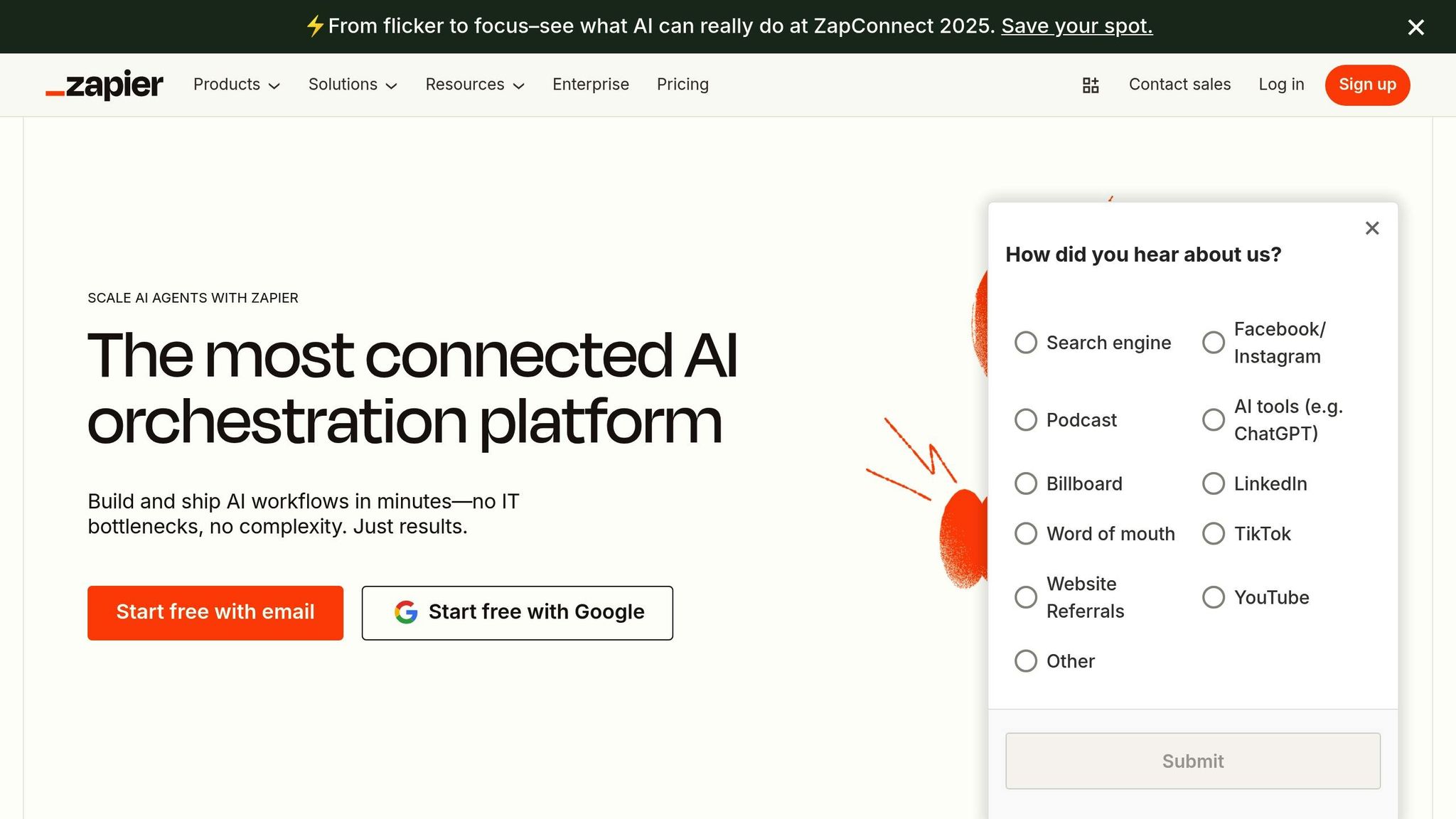
Zapier connects more than 7,000 apps to create smooth, automated workflows. With over 100 million tasks processed using AI, it’s proven itself as a reliable solution for scaling automation needs.
Core Automation Focus
At the heart of Zapier’s functionality are its workflows, called "Zaps." These automations follow a straightforward "if this, then that" logic, transferring data between apps and saving professionals an average of 10 hours each week. For example, 38% of users rely on it for automating repetitive tasks like data entry, and 66% of knowledge workers say automation enables them to focus on more creative work.
"Workflow automation is the act of streamlining and automating a series of tasks within the apps you use... It's all automated".
This makes Zapier especially appealing to small and medium-sized businesses aiming to cut down on time-consuming, manual processes.
Key Features
Zapier is designed with simplicity and connectivity in mind, making it accessible even to non-technical users. Its visual builder allows users to create multi-step automations with ease. Some of its standout features include:
- Tables for streamlined data management.
- Interfaces that let users design custom pages.
- Canvas for visualizing and mapping workflows.
- Options for building custom chatbots.
With its ability to link over 7,000 apps, Zapier ensures seamless integration across a wide range of business tools. These capabilities make it a versatile choice for businesses looking to simplify operations.
Best For
Zapier is ideal for small to medium-sized businesses that need to connect multiple apps and automate repetitive tasks. It’s particularly effective in reducing errors and improving efficiency in workflows like data entry. In fact, 88% of small business owners believe automation gives them a competitive edge, and 34% of knowledge workers report fewer errors thanks to automation.
Pricing
Zapier’s pricing is designed to accommodate businesses of all sizes, with plans that scale based on usage. Annual billing offers savings of about 33%. Here’s a breakdown of the plans:
- Free Plan: $0/month – Includes unlimited two-step Zaps, AI power-ups, and up to 100 tasks per month.
- Pro Plan: $19.99/month (billed annually) – Features multi-step Zaps, unlimited premium apps, webhooks, and email/live chat support.
- Team Plan: $69/month (billed annually) – Tailored for teams with up to 25 users, shared Zaps and folders, SAML SSO, and Premier Support.
- Enterprise Plan: Custom pricing – Offers advanced admin controls, unlimited users, and a dedicated Technical Account Manager.
Additional features like custom chatbots, Interfaces, and Tables can be added for $20/month. If you exceed the task limit, extra charges apply at 1.25 times the base task cost.
With an average user rating of 4.7/5 stars, Zapier is celebrated for its ease of use and strong integration capabilities. Many businesses find it pays for itself by saving time and reducing errors.
sbb-itb-9a5c6df
5. n8n

n8n is an open-source workflow automation platform crafted for technical teams that need precise control over their automation processes. It combines the simplicity of no-code tools with the flexibility and depth that developers appreciate. This makes it a great choice for teams looking to streamline automations while still having the ability to dive into advanced customization.
Core Automation Focus
At the heart of n8n is its node-based design, where each node represents an action or trigger in a workflow. This structure allows technical teams to build workflows that go far beyond basic "if this, then that" logic. When standard integrations fall short, users can incorporate custom JavaScript or Python code. Other advanced features include executing cURL requests, merging workflow branches, and rerunning individual steps without restarting the entire process.
The platform's impact is impressive: Delivery Hero reports saving 200 hours monthly, and StepStone reduced a two-week task to just two hours.
"We've sped up our integration of marketplace data sources by 25X. It takes me 2 hours max to connect up APIs and transform the data we need. You can't do this that fast in code."
- Luka Pilic, Marketplace Tech Lead, StepStone
Key Features
n8n stands out with its intuitive visual workflow editor, which simplifies automation design without sacrificing advanced functionality. It offers both cloud-hosted and self-hosted options, giving organizations full control over their data and security. With access to over 1,700 pre-built templates, users can quickly adapt workflows to meet their needs.
Key features include robust error handling, inline real-time debugging, and data replay, ensuring even the most complex automations run smoothly. Additionally, n8n supports AI-powered workflows, enabling integration with large language models or the option to self-host AI models for greater privacy. These capabilities make it a go-to tool for teams that prioritize flexibility and control.
Best For
n8n is ideal for technically skilled teams, developers, and organizations with complex automation needs that go beyond the capabilities of basic no-code platforms. It shines in areas like backend processes, IT operations, data transformation, and API integrations. Teams using n8n for AI-driven workflows have reported up to a 42% boost in process efficiency compared to traditional automation methods. By simplifying backend operations and integrating seamlessly with custom workflows, n8n helps teams reclaim valuable time.
"The idea is that everybody in the organization can use n8n to manage data retrieval or data transformation."
- Martino Bonfiglioli, Senior Product Manager
With over 126,500 stars on GitHub and a 4.9/5 rating on G2, n8n has earned a strong reputation among teams that value its balance of power and usability.
Pricing
n8n offers flexible pricing options designed to fit different organizational needs. The Community Edition is completely free for self-hosting, making it a great choice for teams with the technical know-how to manage their own infrastructure. For cloud-hosted solutions, the Starter plan costs around $20–24 per month and provides managed hosting without the hassle of self-management. The Pro plan, priced at $50–60 per month, includes advanced features for teams with more complex automation needs. Enterprise customers can opt for custom pricing, which includes perks like SSO integration, dedicated support, and enhanced security controls.
n8n’s ability to handle up to 220 workflow executions per second on a single instance highlights its robust performance, making it a reliable choice for high-volume automation scenarios.
6. Motion
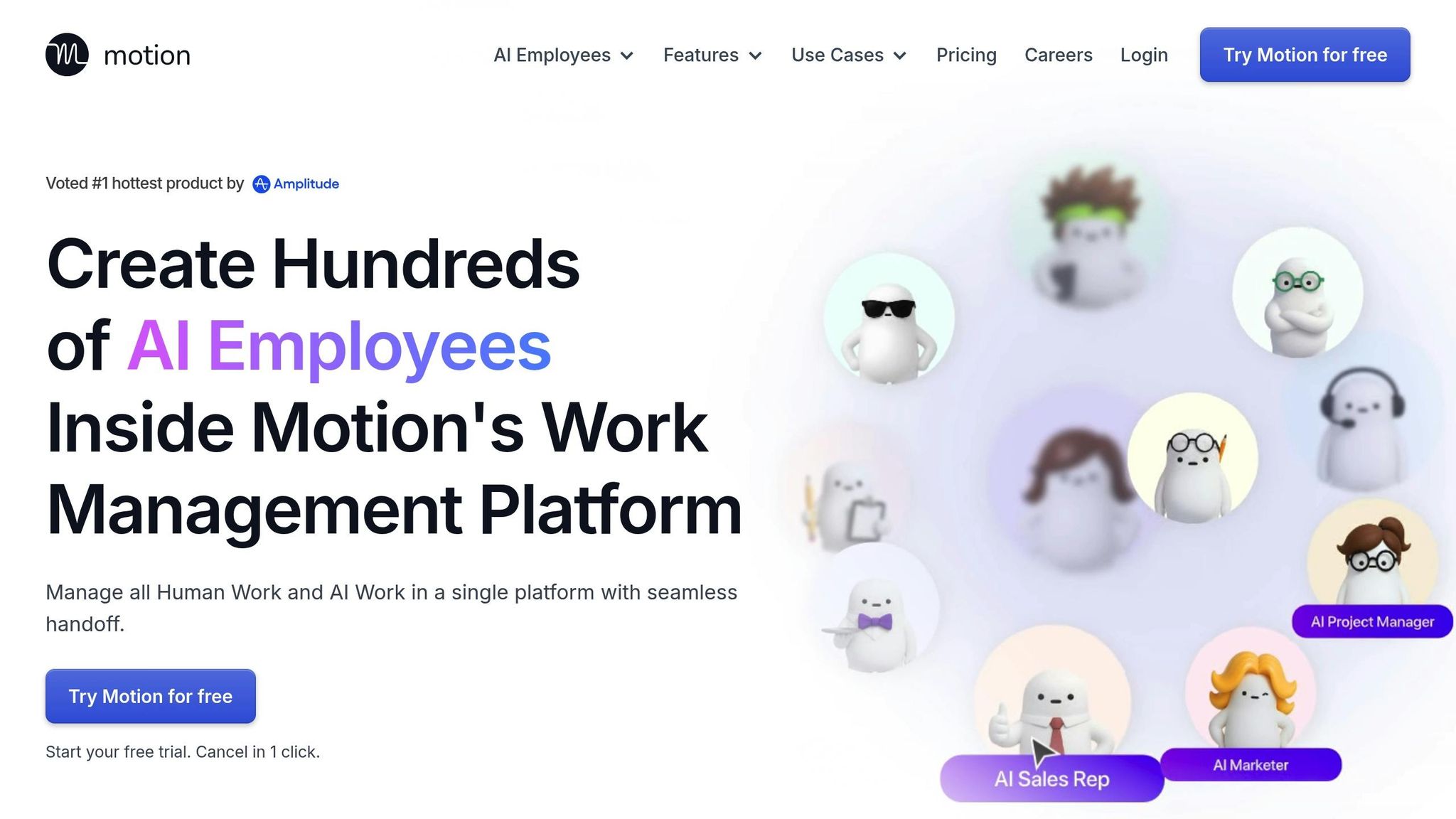
Motion is a productivity platform powered by AI, designed to take the hassle out of scheduling and task management. Unlike traditional tools that require constant manual updates, Motion uses AI to automatically organize your day - planning, prioritizing, and optimizing tasks based on deadlines, priorities, and your availability.
Core Automation Focus
At its heart, Motion focuses on intelligent scheduling and task management by creating optimized schedules that adapt in real time to shifting deadlines and priorities. It takes care of 90% of project planning, removing the need for manual calendar adjustments. Whether a meeting runs over, a deadline changes, or new tasks pop up, Motion's AI dynamically reschedules your day. This streamlined approach helps users reclaim their time, with reports showing an average of 6 productive hours per day - far above the usual 2 hours and 53 minutes - and saving at least 2 hours daily.
"You let yourself go. You put urgency, time, and task details into Motion, and then it shows you the tasks you need to do in the correct order. It helps me be on autopilot."
- Morgan Pelissier, Sparkmate Co-founder
These features form the foundation of Motion's robust toolset, which is designed to make managing work effortless.
Key Features
Motion combines several productivity tools into one AI-driven platform. Its standout features include:
- Intelligent task planning and calendar integration: Automatically prioritizes tasks based on deadlines and importance, while ensuring meetings and focus time are balanced.
- Meeting Notetaker: Delivers accurate transcriptions, outperforming manual note-taking by 80%.
- Optimization engine: Reduces downtime between project phases, speeding up project completion by 32%.
- Integrations: Seamlessly connects with tools like Google Calendar, Gmail, Microsoft Outlook, Zoom, and Zapier.
On top of these, Motion's analytics help teams identify bottlenecks, leading to a 40% boost in efficiency. Overall, users report a 137% increase in productivity compared to platforms that rely on manual updates [67, 70].
Best For
Motion is ideal for professionals and teams managing multiple projects who want to reclaim valuable hours. Its AI-driven scheduling helps reduce decision fatigue and cuts down on "work about work", which can eat up as much as 60% of a team's time. By automating these processes, users save up to 3.5 hours per person every day.
Real-World Impact
Motion has delivered tangible results for its users. MP Cloud, for instance, eliminated daily scrum meetings and reduced management overhead, while Ally Advantage tripled its project management efficiency through automated resource allocation. Another company reported generating an extra $700,000 annually by completing client projects faster, and one organization saved $250,000 a year by reducing time spent on emails and coordination meetings.
"Motion helps me be reasonable with my time... It helps me prioritize my tasks and keep me on track. I use it every day."
- Charlotte R, Verified User on G2
Pricing
Motion offers two pricing options: an Individual plan for $19/month (billed annually) and a Team plan for $12/user per month (billed annually), which includes collaboration and coordination tools.
Though its pricing is higher than basic task management apps, Motion's value-for-money rating of 4.1 out of 5 reflects the significant time savings and productivity gains it delivers [65, 73].
7. Fathom

Fathom is an AI-powered meeting assistant designed to simplify meeting documentation and follow-up tasks. It automates recording, transcription, and summarization for platforms like Zoom, Google Meet, and Microsoft Teams, so you can ditch manual note-taking and stay focused on the conversation.
Core Automation Focus
Fathom takes the hassle out of note-taking by automatically recording, transcribing, and summarizing meetings. Within just 30 seconds, it identifies action items, key decisions, and important moments, ensuring you capture everything without losing focus on the discussion.
With just a click, you can highlight key moments and create shareable clips that offer more context than a basic text summary. This streamlined process helps boost productivity and keeps everyone on the same page.
"Our biggest win is that our team can be PRESENT during the call rather than scrambling to write down the major issues or points to follow up on." - Ryan King
Key Features
Fathom comes packed with time-saving features:
- CRM Integration: Automatically syncs meeting summaries, action items, and insights with tools like Salesforce, HubSpot, and Slack, cutting out manual updates.
- AI-Powered Search: Quickly locate specific details from past meetings without having to rewatch the entire recording.
- Effortless Sharing: Easily share meeting clips and summaries to keep teams aligned.
These capabilities make Fathom particularly useful for customer-facing teams, helping them streamline follow-up tasks and focus on delivering results.
Best For
Fathom is a perfect fit for professionals who frequently interact with clients or manage multiple meetings:
- Sales teams, customer success managers, and consultants can stay organized and focused during client calls.
- Project managers and team leaders can track decisions and follow-up tasks with ease.
- Performance coaches benefit from analyzing communication dynamics without being distracted by note-taking.
"Fathom allows me to concentrate on HOW people communicate and less on WHAT people communicate. As a performance coach this is vital. I can always go back and check the video/transcript/summary to get into the details." - Luke Crane
Real-World Impact
Fathom saves an average of 20 minutes per meeting by automating documentation, which adds up to about 1.5 weeks of saved time per year. It’s no surprise that Fathom holds the top spot as the #1 AI meeting assistant, with a flawless 5/5 rating from over 4,000 reviews. Its Net Promoter Score of 81 even beats Starbucks' score of 77.
Pricing
Fathom offers flexible pricing plans to suit different needs:
- Free Plan: $0, great for individuals or small teams just getting started.
- Premium Plan: $15 per user/month (billed annually) or $19 per user/month (billed monthly), ideal for teams needing advanced analytics and playlist creation.
- Team Edition: $19 per user/month (annually) or $29 per user/month (monthly), tailored for larger teams.
- Team Edition Pro: $29 per user/month (annually) or $39 per user/month (monthly), offering unlimited automation and team-wide playlist capabilities.
Whether you’re a solo professional or managing a large team, Fathom’s pricing options make it easy to find a plan that works for you.
Tool Comparison Table
Here's a quick comparison to help you decide which tool aligns best with your workflow needs:
| Tool | Core Automation Focus | Key Features | Best Use Cases | Pricing (USD) | Advantages | Limitations |
|---|---|---|---|---|---|---|
| TheShed.io | See detailed review | See detailed review | See detailed review | Freemium model | See detailed review | See detailed review |
| Relevance AI | See detailed review | See detailed review | See detailed review | Free plan; Pro: $19/month; Team: $199/month; Business: $599/month | See detailed review | See detailed review |
| Stack AI | See detailed review | See detailed review | See detailed review | Free plan; Starter: $199/month; Team: $899/month | See detailed review | See detailed review |
| Zapier | App integration and workflow automation | Supports 7,000+ app integrations and multi‐step workflows | Small to medium businesses, marketers | Free (100 tasks/month); Pro: $19.99/month; Team: $69/month | Vast app ecosystem; intuitive | Costs may increase with high usage |
| n8n | Open‐source workflow automation | Self‐hosted option; visual workflow builder | Developers and technical teams | Free (self‐hosted); Cloud Starter: $20/month; Pro: $50/month | Full control over data; cost‐effective | Requires technical setup for self‐hosting |
| Motion | Calendar and task automation | Intelligent scheduling and automatic task management | Busy professionals and executives | Individual: $19/month; Team: $12/month per user | Efficient scheduling and time management | Primarily focused on calendar functions |
| Fathom | See detailed review | See detailed review | See detailed review | Free plan; Premium: $15/month; Team Edition: $19/month; Team Edition Pro: $29/month | See detailed review | See detailed review |
This table outlines the key differences among the tools, helping you identify the one that best suits your automation needs. For a deeper dive into features and pricing, check the detailed sections above.
Conclusion
To wrap up, the tools highlighted in this guide each address specific areas of workflow optimization. From connecting apps and managing schedules to analyzing data and improving communication, these seven automation tools are designed to simplify daily tasks and save time. When used wisely, they can help you reclaim up to 10 hours each week.
As mentioned earlier, automation can significantly reduce repetitive work. For instance, businesses can save over 6 hours a week simply by automating social media content and advertising tasks. When applied across multiple areas of a business, the cumulative time savings can be transformative. Juan Perez, EVP and CIO of Salesforce, emphasizes this point:
"Automation is no longer a nice-to-have; it's a must-have, because automation tools improve both business and employee performance."
Beyond saving time, automation helps reduce stress, boost productivity, and improve overall efficiency. Knowledge workers have consistently reported feeling more productive thanks to automation.
The real challenge lies in selecting the right tools tailored to your specific needs. Not all solutions are equally effective, and choosing tools that integrate seamlessly with your existing systems is crucial. This is where platforms like TheShed.io become incredibly helpful, offering a centralized directory to explore and compare automation tools across various categories. This makes it easier to find solutions that fit your unique workflow.
Whether your goal is to eliminate repetitive tasks, enhance team collaboration, or extract actionable insights from data, the tools in this guide provide a clear roadmap to achieving those goals. By investing in automation, you not only save time but also reduce errors, scale operations more effectively, and free up resources to focus on strategic work that drives your business forward.
FAQs
How can I identify which tasks in my business should be automated?
To figure out which tasks in your business are perfect candidates for automation, start by zeroing in on processes that are repetitive, time-intensive, and rule-driven. Think about tasks like data entry, organizing emails, or generating reports - things that are done often and can be prone to human mistakes.
Next, take a closer look at activities that demand a fast turnaround or involve managing large amounts of data. Automating these can save valuable time and boost overall efficiency. It's a good idea to involve your team in this process - they can help identify areas where automation might eliminate bottlenecks or free up time for more strategic, high-value work.
Lastly, focus on tasks that align closely with your business objectives and promise the best return on investment. Setting clear goals and gathering input from stakeholders will ensure you're automating the right processes to deliver the biggest impact.
What should I consider when selecting an automation tool for my team?
When picking an automation tool for your team, the first step is to clearly define your needs and objectives. Look at factors such as how easy it is to use, its compatibility with your current tools, and whether it works well with your existing technology stack. The tool should fit seamlessly into your team's workflows and complement their skill set.
You’ll also want to assess the cost, scalability, and the level of maintenance it requires over time. The right automation tool should do more than just handle repetitive tasks - it should also be capable of growing alongside your business and adapting to future demands.
How do automation tools boost employee satisfaction and reduce workplace stress?
Automation tools play a key role in boosting employee morale and lowering stress levels. By handling repetitive, time-consuming tasks, these tools free up employees to concentrate on work that's more meaningful and engaging. This shift not only enhances productivity but also contributes to a healthier work-life balance, leaving employees feeling less overwhelmed and more accomplished.
Simplifying workflows through automation also reduces the mental load of managing mundane tasks. The result? A more positive and efficient workplace atmosphere. Over time, this can translate into greater job satisfaction and a deeper sense of purpose and value among team members.
.svg)






